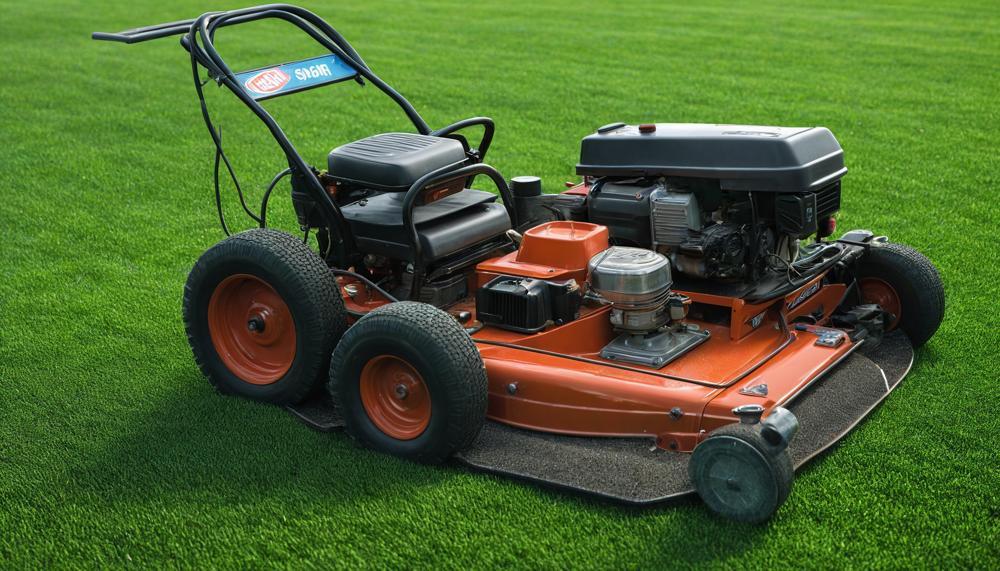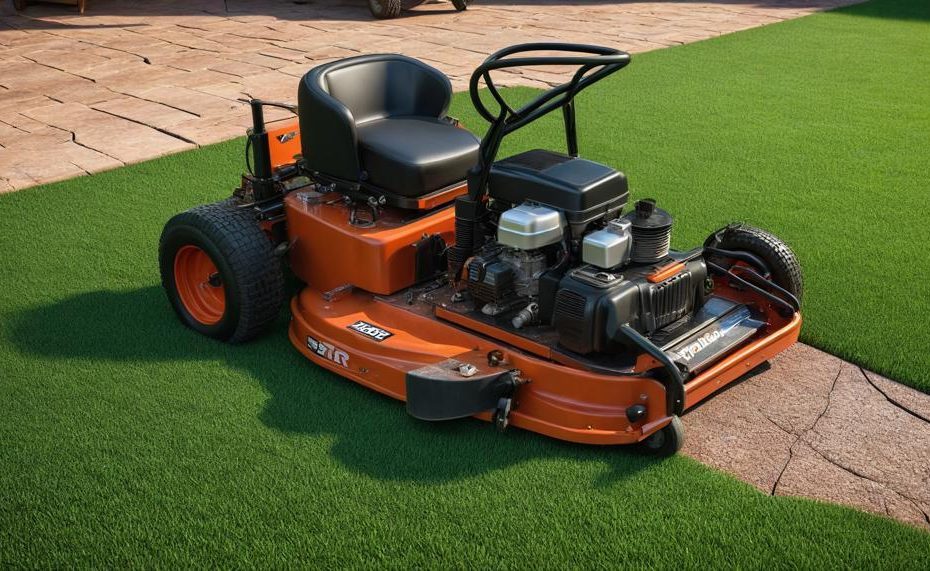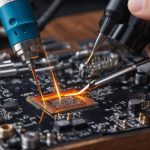In the world of gardening and landscaping, your lawn mower is more than just a tool—it’s your trusted ally in maintaining a pristine lawn. However, even the most robust machines can face the dreaded issue of a cracked deck, turning your once serene lawn maintenance routine into a vexing challenge. But what if I told you that there’s a silver lining to this seemingly grim situation? Yes, the answer lies in welding—a skill that might seem intimidating at first but can breathe new life into your ailing lawn mower deck.
In this blog post, we’re diving deep into the art and science of repairing a cracked lawn mower deck by wielding the power of welding. Whether you’re a seasoned DIY enthusiast or a newcomer to the world of metal repair, this guide is designed to navigate you through the process with ease and confidence. Here’s a sneak peek of the critical insights you’re about to discover:
- Understanding the Crack: We’ll start by identifying the type of crack you’re dealing with and what it means for your repair strategy.
- Preparation is Key: Learn how to prepare the cracked area for welding, ensuring a successful and durable repair.
- Choosing the Right Welding Method: Not all welding techniques are created equal. We’ll explore the options and help you select the best one for your lawn mower deck’s material and thickness.
- Welding 101: A step-by-step guide to the actual welding process, tailored for beginners and seasoned DIYers alike.
- Post-Welding Care: Tips on how to treat your freshly repaired deck to prevent future cracks and ensure a long-lasting fix.
Armed with the right knowledge and a bit of patience, you’ll see that repairing a cracked lawn mower deck is not just possible but can be a rewarding endeavor. So, grab your welding gear, and let’s turn this challenge into an opportunity to extend the life of your beloved lawn mower.
Contents
- 1 What Factors Determine Whether You Can Weld a Cracked Lawn Mower Deck?
- 2 Preparing for the Welding Process
- 3 Cleaning the Area Around the Crack
- 4 Setting Up the Welder
- 5 The Welding Process
- 6 Is Welding a Cracked Lawn Mower Deck a Permanent Fix?
- 7 Advantages of Welding a Cracked Lawn Mower Deck
- 8 Disadvantages of Welding a Cracked Lawn Mower Deck
- 9 Conclusion
What Factors Determine Whether You Can Weld a Cracked Lawn Mower Deck?
The feasibility of welding a cracked lawn mower deck hinges on several critical aspects. These factors ensure the repair’s durability, functionality, and safety. Below is a breakdown of the main determinants:

| Factor | Detail | Why It Matters |
| Extent of Damage | Severity and location of the crack | Affects the repair’s complexity and success likelihood. |
| Material Type | Steel vs. Aluminum | Steel is more weld-friendly than aluminum, impacting repair feasibility. |
| Metal Thickness | Gauge of the deck’s metal | Thin metals risk warping from welding heat; thickness guides technique. |
| Welder Expertise | Repairer’s skill level | Highly skilled welders increase the success rate of repairs. |
| Preparation | Cleaning, grinding the crack | Proper prep is key to a strong, durable weld. |
| Welding Equipment | Type of welder and welding rod | Choosing suitable tools ensures a quality repair. |
| Safety Measures | Use of protective gear | Essential to prevent injuries during the repair process. |
| Maintenance Post-Weld | Regular inspection | Extends the life of the repair and identifies potential future issues. |
To stitch a cracked deck back into prime condition, each of these factors must be meticulously considered. From the preliminary examination of the damage to the selection of appropriate welding techniques and safety protocols, every step plays a pivotal role.
Especially, the type of material and the metal’s thickness not only influence the welding approach but also determine the heat settings and the choice of welding rod.
Furthermore, the welder’s expertise cannot be overstated; a seasoned hand ensures the weld is both strong and aesthetically pleasing, blending skill with the nuances of metalwork.
Preparing for the Welding Process
When tackling a project like welding a cracked lawn mower deck, preparation is as vital as the welding itself. Follow these steps to ensure a robust and safe repair:
Damage Assessment and Material Check
- Examine the crack’s extent and identify the deck’s material.
Gather Necessary Equipment and Safety Gear
- Required tools: Welding machine, helmet, gloves, safety glasses, respiratory mask.
Surface Preparation
- Clean the area with a wire brush or grinding disc to eliminate rust and debris.
Metal Thickness and Weld Settings
- Choose suitable wire and heat settings, considering the deck’s metal thickness.
Safety and Positioning
- Clear flammable materials, securely position the deck.
Crack Preparation
- Clean around the crack, removing dirt and oil, and grind a groove for welding penetration.
Welder and Rod Selection
- Decide between MIG or TIG welding, and pick the right welding rod.
Voltage and Wire Speed Adjustment
- Set your machine’s voltage and wire speed according to the steel thickness.
Deck Positioning for Welding
- Position the deck for optimal visibility and accessibility.
Consider Potential Drawbacks
- Be aware of risks like weakening of surrounding metal, warping, visible welds, and future corrosion.
Cleaning the Area Around the Crack
To prep the area around a cracked lawn mower deck for welding, meticulous cleaning is paramount. Here’s how you ace it:
- Scour away rust and dirt: Start by employing a wire brush or grinding disc. This step ensures any corrosion or loose particles are banished, setting the stage for a clean welding surface.
- Degrease: Next, eliminate any oil or grime. Using a degreaser, wipe down the area thoroughly. A clean surface guarantees the welding process isn’t hindered by contaminants.
- Smooth the crack edges: With a grinding disc, refine the edges of the crack. This not only removes additional rust but also creates an ideal shape for welding, promoting a stronger join.
- Safety First: Don your welding mask, gloves, safety glasses, and a respiratory mask. Protecting yourself from sparks, debris, and fumes is crucial.
- Assess and prepare: Consider the metal’s thickness and material. This influences your choice of welding method and gear, ensuring a seamless repair.
- Secure the deck: Fix the lawn mower deck in place before starting. Stability is key to an even, precise weld.
- Regular checks: Post-repair, keep an eye on the deck for any signs of wear. Regular inspections can extend its life significantly.
- Choose MIG or TIG: Depending on the material and thickness, opt for MIG or TIG welding. Both demand clean surfaces for a robust bond.
Cleaning the area around the crack correctly is a blend of art and science. It’s about being thorough, cautious, and respecting the materials you’re working with. Here’s a table summarizing the key steps:
Setting Up the Welder
To mend a cracked lawn mower deck with a welder, adhering to precise steps ensures the repair’s durability and safety. Here’s how to ace the setup:
| Step | Action | Details |
|---|---|---|
| 1 | Clean the Crack Area | Scrub around the crack using a wire brush. Remove any rust, paint, or debris to ensure a clean welding surface. |
| 2 | Select Welder and Rod | Opt for a MIG welder with a compatible welding rod for steel. The choice depends on the metal thickness and type. |
| 3 | Adjust Settings | Tweak the voltage and wire speed to match the steel deck’s thickness. Incorrect settings can lead to weak welds. |
| 4 | Position the Deck | Secure the lawn mower deck at an angle that allows clear visibility and easy access to the crack. |
| 5 | Don Safety Gear | Wear protective equipment: a welding helmet, gloves, and apron to safeguard against sparks and UV light. |
| 6 | Final Checks | Ensure the work area is safe, the deck is stable, and you have clear access to the work zone. |
Getting these steps right isn’t just about fixing a crack; it’s about breathing new life into your lawn mower deck. A well-executed weld not only saves the deck from the scrap heap but also ensures it stands up to the rigors of mowing without succumbing to further damage or distortion.
The Welding Process
Repairing a cracked lawn mower deck through welding involves a sequence of meticulous steps to ensure the longevity and functionality of the deck post-repair. Below is a structured approach to the welding process, delineated with emphasis on preparation, execution, and post-welding care, taking into account the research insights provided:
| Step | Action | Details |
| Assessment and Preparation | Inspect and clean the crack area | Clean removal of debris, rust, and paint |
| Selecting Equipment | Choose appropriate welding method | MIG for steel decks, considering material thickness |
| Safety Measures | Wear protective gear | Glasses, gloves, helmet |
| Welding Execution | Secure deck, weld carefully | Deep penetration weld, adjust equipment settings |
| Post-Welding Care | Cool, inspect, maintain | Natural cooling, regular checks for integrity |
By adhering to these steps, you can effectively mend a cracked lawn mower deck, ensuring it’s ready to tackle the garden once again.
Is Welding a Cracked Lawn Mower Deck a Permanent Fix?
Welding a cracked lawn mower deck can indeed be a durable repair method, albeit with caveats. The permanence of the fix hinges on multiple factors, such as the severity of the crack, the material’s quality, and the expertise of the individual wielding the welder.
When executed with precision and the correct preparation, welding has the potential to extend the life of your lawn mower deck significantly.
However, it’s crucial to acknowledge that despite being robust, the fix might not be everlasting due to factors like metal fatigue and ongoing wear and tear.
Key Considerations for a Lasting Weld:
- Extent of Damage: The size and location of the crack significantly influence repair longevity.
- Material Type and Thickness: Different metals require distinct welding approaches for optimal results.
- Welder Expertise: The skill level of the person performing the weld impacts the quality and durability of the repair.
- Preparation and Equipment: Proper cleaning and the right tools are paramount for a successful weld.
Pros and Cons of Welding a Lawn Mower Deck:
| Pros | Cons |
| Cost-effective compared to replacement | Potential weakening of surrounding metal |
| Extends the usable life of the deck | Risk of warping or distortion |
| Immediate repair solution | Visible weld marks may remain |
In sum, while welding can offer a sturdy solution to a cracked lawn mower deck, it’s not an infallible or permanent fix. Regular inspections and maintenance post-repair are crucial to monitor the deck’s condition and ensure its longevity.
Advantages of Welding a Cracked Lawn Mower Deck
Welding a cracked lawn mower deck, instead of shelling out for a new one, comes with a bunch of perks that aren’t just good for your pocket. It’s quicker, greener, and if you do it right, it can make your deck tougher than it was.
Plus, you get to dabble in a bit of customization, depending on how you weld it back together. Let’s break down these benefits in a simple way, so it’s clear why welding is a solid choice:
| Saves Money | Welding patches up your deck without the need to buy a new one, keeping your hard-earned cash in your pocket. | 💰 |
| Quick Fix | A welder can sort out your problem in a few hours, getting you back to mowing in no time. | ⏱️ |
| Eco-Friendly | By fixing what you’ve got, you’re cutting down on waste. It’s a win for your wallet and the planet. | 🌍 |
| Strengthens Deck | The heat from welding fuses steel, making the repaired area often stronger than its original state. | 💪 |
| Customization | Choosing how to weld lets you add personal touches or strengthen specific areas of the deck. | 🛠️ |
| Long-Term Fix | Done properly, welding can make your deck last longer before you even think about replacing it. | 🕒 |
So, if you’ve got a crack in your mower deck, don’t rush to replace it. Welding can save you a bundle, is kinder to our planet, and can even leave your mower deck better off than it was. Plus, it’s a chance to get creative with your repair.
Disadvantages of Welding a Cracked Lawn Mower Deck
Welding a cracked lawn mower deck, though beneficial in many cases, carries certain disadvantages that must be taken into account:
Weakening of Surrounding Metal:
Heat from welding can lead to the weakening of the metal surrounding the crack. This area might become more susceptible to future cracks due to the heat-affected zone losing its original strength.
Warping or Distortion:
Due to uneven heating and cooling, the metal can warp or distort, affecting the deck’s flatness and potentially its functionality.
Visible Welds:
Welds can be unsightly and may not blend well with the original design, impacting the overall appearance of the lawn mower.
Future Failures:
The area around the weld may become a new point of stress, leading to further cracks or breaks, especially under the constant vibration and stress of mowing.
Corrosion:
Welded areas can be prone to rust and corrosion if not properly sealed and painted after repair, leading to additional maintenance requirements.
Requirement for Regular Maintenance:
A welded deck requires regular inspections and maintenance to ensure the integrity of the repair holds up over time.
Conclusion
Welding a cracked lawn mower deck emerges as a beacon of hope for garden enthusiasts facing the nuisance of equipment damage. Not merely a repair method, welding is a revival, transforming a despairing sight into a lawn’s steadfast companion. This article demystifies the welding process, making it accessible for both neophytes and seasoned DIYers, guiding through essential steps from diagnosis to the triumphant restoration.
The narrative underscores a critical truth: welding isn’t a mere act of joining metals; it’s an art that requires precision, understanding, and respect for the material. The journey from assessing the damage to executing a flawless weld encapsulates a blend of science and craftsmanship, ensuring the mower deck not only returns to functionality but also gains resilience.
However, the story of welding does not end with the cooling of molten metal. The aftermath of welding – the diligent maintenance, the vigilant inspections – highlights an often-overlooked virtue: persistence. Welding extends beyond a one-time fix; it’s a commitment to ongoing care, a testament to the durability and sustainability of our tools.
Embracing the challenge of welding a cracked lawn mower deck symbolizes more than a mere repair; it embodies the spirit of resilience, innovation, and environmental stewardship.





